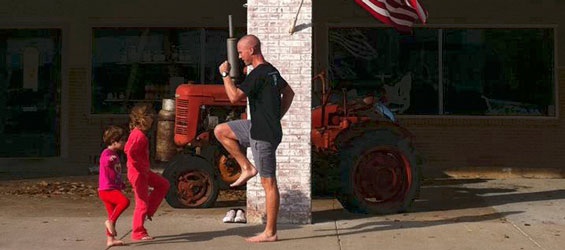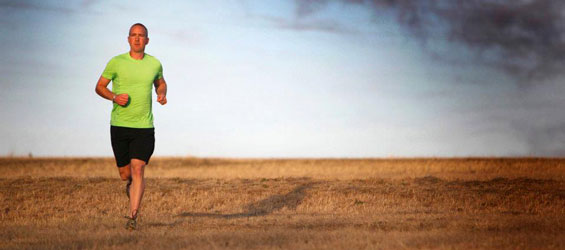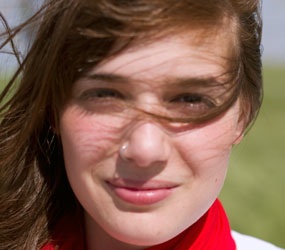From His Tribe to Yours
 Sprawled across his backyard like a modern day chariot is what Patton refers to as the “Offspring Express.” Instead of two horses, there is a bright orange double running stroller. Instead of a two-wheeled conveyance, resides a royal blue bike trailer. Patton, the six-foot, buzz cut, and visor wearing charioteer runs between the strollers, grasping the two eight-and-a-half feet PVC pipes lashed between the strollers like reins. When asked about the contraption, Patton nonchalantly responds with a chuckle, “We do everything as a family. This is great for training and gets everybody out of the house. The kids even rotate seats to keep it fresh.”
Sprawled across his backyard like a modern day chariot is what Patton refers to as the “Offspring Express.” Instead of two horses, there is a bright orange double running stroller. Instead of a two-wheeled conveyance, resides a royal blue bike trailer. Patton, the six-foot, buzz cut, and visor wearing charioteer runs between the strollers, grasping the two eight-and-a-half feet PVC pipes lashed between the strollers like reins. When asked about the contraption, Patton nonchalantly responds with a chuckle, “We do everything as a family. This is great for training and gets everybody out of the house. The kids even rotate seats to keep it fresh.”
Just a decade ago, Patton, a seasoned runner and owner of an online running store, would not have been able to join his wife and their gaggle on family runs. “Before a recovery run, I stepped off the porch and felt the most excruciating pain I’ve ever experienced,” said Patton, “I tried everything and even had doctors tell me I should give up and start cycling.” In 2001, at the end of his first ultra-marathon, the Great Eastern 50k (a race covering the distance beyond the normal 26.2 miles commonly in increments of 50k, 100k, 50 miles, 100 miles), Patton withstood an Iliotibial-band (a fibrous reinforcement on the outside of the thigh stretching from the hip to the knee) injury that would keep him from running for almost two years. Patton’s injury occurred a few days after his 50k.
Two years later, while reading a book about triathlons, Patton discovered what he now terms “natural running” or the way the human body was meant to run in its purest form – namely, barefoot across a solid surface. This type of running has become more than just a running style for Patton; it has become a lifestyle (and a means of income) for the Gleason family.
Sitting on his back porch, arms wrapped around his oldest daughter Annie, Patton began recounting his early running experiences, “I ran in high school. I was good but not great. My training technique was antiquated. Technique should have been everything.” Patton still believes technique or form is everything, but for high school athletes, the coaches’ training is dogmatic and comes from reading books or Runner’s World, which can be ineffective. Expressing the tenseness of one attempting to hide frustration, Patton verbalized his concerns: “No one really cared about what running form looked like, not like they cared about what a batting swing, or a quarterback throwing a ball looked like. No one could tell you how to run without getting hurt.” The concerns he has about not teaching correct running form are also the concerns of others. In the 1960s, the company that would one day become Nike produced the Cortez (the first cushioned running shoe.) Journalist Christopher McDougall reported: “The Cortez [primarily invented for runners] allowed people to run in a way no human safely could before: by landing on their bony heels.”
Before the invention of a cushioned shoe, experienced runners and Olympians such as Roger Bannister (the first man to run a mile under four minutes) and Jesse Owens (a young African-American winning four gold medals in the 1936 Berlin Olympics) all ran in a forefoot-to-midfoot approach: with back straight, knees bent, feet landing underneath their hips in thin canvas or leather racing flats. Their technique mattered because the only shock absorption these men possessed came from the compression of their legs and their thick pad of midfoot fat. Fred Wilt, author of How They Train informs readers that in 1959, more than eighty of the world’s top runners used the same technique. This technique, which man had always used for running, fell out of style when the Cortez became popular; adding a thicker sole would allow the runner to land on their heels gaining extra inches. While the creators of Nike and the Cortez felt this heel-to-toe approach was better than the forefoot-to-midfoot approach, what saved Patton’s running career was reverting back to the original and efficient running style of the 1950s (and since humans have been present on earth).
“Late in 2003, I was reading The Triathletes Training Bible, and it treated running as a skill, just like swimming or cycling,” the natural runner told me, becoming more and more excited as he continued. “It discussed good posture, running with a quick cadence, and landing under one’s center of mass because these movements minimize impact. It is what our bodies do naturally. The book encouraged doing exercises barefoot way before this ‘barefoot revolution.’ So, I bought a pair of wool socks, went to a soccer field in the middle of winter, and started running loops.” For some the barefoot revolution may be a temporary craze, but for Patton running barefoot changed his life. Running barefoot allows more range of motion in the foot and engages more of the toes and allows less pronation because more effective distribution of pressure. Even Dr. Irene Davis, one of the most knowledgeable researchers and doctors in sports medicine and running injuries, has been persuaded by the positive feedback she has received from her patients.
After seeing the drastic improvements from running barefoot, Patton and his wife, Andrea, began creating a business plan for a running company based on his new found state of nirvana: the human body does not need modification. “There are so many things about running and the way the human body should move that are not true. But natural running changes that. Move the way your body was designed to, whether you subscribe to evolution or creation, which is efficiently pain free.” Patton pauses and then begins laughing, “And with a big, fat smile on your face. That’s as close to an unalienable right as you can possibly get because that is something everybody gets a shot at.”
Daylight fades in the Gleason backyard as Patton continues relating his business plan and helping his two young daughters roast pink heart-shaped marshmallows in a large chiminea. On January 6, 2005, “Andrea and I wrote down our original business plan,” Patton says while managing his daughters’ marshmallows. “We moved to North Texas and into a house with my parents. We had no health insurance. Just as we were about to put money down to open a running store, Andrea found out we were pregnant with Annie.” The plans for the store were put on hold as Patton began working at the front desk of a recreation center and Andrea as a teacher. “I started working at a local running store. I couldn’t put out the fire of wanting to open my own store and this new job was sort of a trial run.”
Patton’s trial run proved to be a perfect fit for his passions and strengths. He opened a couple of stores for the running company and directed a few programs. There were things within the industry that he felt were inflexible and not very accurate- especially when it came to injury treatment and how feet are formed. “I thought my idea was more appropriate for a concept of a running store: not based on selling shoes but based on empowering an athlete. It’s not about selling crap. It’s not about how we’re all broken and need to be fixed. It’s not about a product.” He would still sell shoes, but only running shoes that promote an accurate running form.
Bill Bowerman, University of Oregon running coach and the inventor of the Cortez, quickly realized his mistake; his original mission of making an honest shoe had turned into making money. In a letter to a friend, Bowerman wrote that Nike was “distributing a lot of crap.” The Nike Swoosh had become a world power manufacturing a disconcerting variety of shoes and changing models every year just to have something new to sell. In 2002, when barefoot running surfaced again (and again in 2009 after Born to Run was published), Nike went to Bowerman’s running mentor, Arthur Lydiard, to see if they had been at all mistaken about cushioning and if barefoot running had any merit. Lydiard replied, “Of course! You support an area, it gets weaker. Use it extensively, it gets stronger…. Run barefoot and you don’t have all those troubles. Shoes that let your foot function like you’re barefoot—they’re the shoes for me.” Out of this encounter, Nike developed their swooshed slippers, the Nike Free. Its slogan: Run Barefoot.
Patton’s business plan reflected Arthur Lydiard’s sentiments- find shoes that let feet function as if one is barefoot. His dreams became reality in 2009, when he launched his ecommerce business: Natural Running Store. “It’s not about a product,” claims Patton, “Luke’s Locker sells Vibrams but Walmart sells organic food. It’s all about technique and promoting shoes and companies that compliment this technique. By starting my own company I don’t have to compromise any of my values. The companies we work with, we have high standards and as long as I own this company there will be brands that we will never carry.” Patton’s company strives to promote products that provide a more natural way of moving and enhance an appropriate perception of the ground. He does not only sell shoes. Patton also hosts clinics, constant video chats, and the “100 Up Challenge.” His work solely supports that you are not broken.

It is called “The Warehouse.” Located in the middle of a quiet McKinney cul-de-sac is the headquarters for all Natural Running Store operations. It is not really a warehouse but the Gleason’s garage; along the right wall are folding tables which serve as desks while the rest of the room is filled with shelves stacked with hundreds of boxes of shoes waiting to be shipped to eager customers. Patton’s first employee (or tribe member) John McIntosh says, “the warehouse is a really great picture of Patton himself. He’s all about function and not about looks. What is going to get the job done the right way, the first time?” John and Patton first met at one of Patton’s running clinics during the summer of 2011. As the NRS became more popular among natural runners, Patton needed more help around the warehouse and hired John. “My first impression of Patton is that his excitement and enthusiasm is contagious,” John testifies with a large grin. “It is refreshing being around Patton, especially in the job market. People do what they don’t enjoy just to make money, but regardless of whether he’s going to make money or not, Patton is going to enjoy what he does.” Dan Westfield, a former running coach at EnduraLab, which houses NRS’ satellite store, echoes John’s sentiments: “I started running with Patton after I tore my hamstring. I couldn’t get over his positive attitude; when we would run, I would be in pain but I didn’t want to fall behind or stop because I enjoyed our conversations so much.”
Natural Running Store has grown exponentially in the short amount of time it has been a reality. “Staying in the garage was out of necessity so we could spend more money on the customers and creating a more marketable brand. The dynamic has been incredible though, a dream come true.” Like Patton, Andrea also works from home. She has her own business making wedding accessories and homeschooling the three Gleason children. Patton believes, “My kids get to see that if every day you wake up and hustle, make do with what you have, and make no excuses, then your dream can come true. There is always a big risk that the Natural Running Store could fail, but it would never be for lack of hustle. My family gets to experience all this with me, the good days and the bad.” Andrea agrees with her husband adding, “We have some crazy times but we wouldn’t trade them for anything.” When their six year old, Annie was asked about having her parents at home every day her face lit up with joy. She giggled shyly and said, “I like helping in the garage! I help with videos, writing notes, and drawing pictures.” Patton proudly listed the businesses Annie plans to start: a lemonade stand, teaching other kids how to run, or an art gallery with her paintings.
The future of Natural Running Store looks bright, between expanding and developing more satellite stores. Andrea states, “Running is no longer a hobby for us. It’s now the whole shebang, trailers in tow.” Watching the fire in the chiminea finally die down, Patton expresses that his movement is not for everyone: “We love the idea that you were born to run, born to be happy and born to have a pretty epic life. Let’s run because it brings joy; run with a smile and the whole world in front of you.”
